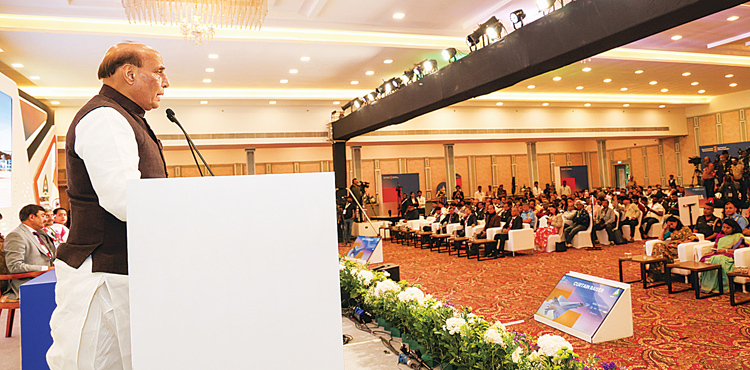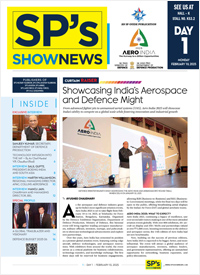Aero India 2025: The Defence Sector is Powering the Growth Engine of the Indian Economy, says Rajnath Singh
For the emerging Indian economy, Aero India 2025 will serve as a platform for strengthening international collaboration, showcasing India's strategic role in the global defence ecosystem

Aero India 2025, one of the largest aerospace and defence exhibitions in Asia, promises to be a showcase of India's advancements in aviation, aerospace, and defence technologies. With a growing emphasis on self-reliance, the event is not just an exhibition, but a symbol of India's commitment to enhancing its domestic defence capabilities, both in production and innovation.
Defence Minister Rajnath Singh in his curtain-raiser address stressed that the defence industrial sector, which was earlier not viewed as a component of the national economy, has today been fully integrated with the overall economy. The sector is now a motor, powering the growth engine of the Indian economy, he said.
He also outlined the record allocation of ₹6.81 lakh crore to the Ministry of Defence in the Union Budget 2025-26, including ₹1.80 lakh crore for capital acquisition. He added that like the previous budget, 75 per cent of the modernisation budget has been reserved for procurement through domestic sources with an aim to widen and deepen the capabilities of India's Defence Industrial Complex.
RAJNATH SINGH PUTS HIS THRUST FOR SELF-RELIANCE IN DEFENCE
Defence Minister Rajnath Singh has been a vocal proponent of 'Atmanirbhar Bharat' (Self-Reliant India) in the defence sector. Under his leadership, the Indian government has made it a priority to reduce dependency on foreign imports and boost indigenous defence manufacturing. In recent years, India has made significant strides towards this vision, focusing on increasing domestic production, fostering private-sector involvement, and promoting cuttingedge technologies in defence manufacturing.
Rajnath Singh stated that the five-day event will witness the participation of Government Representatives, Industry Leaders, Air Force Officers, Scientists, Defence Sector Experts, Startups, Academia & other stakeholders from all across the globe, and this confluence would bring India's partners closer to the benefit of all.
He added that the defence manufacturers are working with a collaborative approach to strengthen the defence sector and added that today India has become a Globally Preferred Destination for Aerospace Components & Complex System Assembly and the public sector & private industries are playing an important role in this transformation.
Widening the scope of 'Make in India in Defence' He calls for strengthening the relations among like-minded countries to deal with today's uncertainties.
"We often interact as buyers and sellers, where our relations are at a transactional level. However, at another level, we forge our partnership beyond the buyer-seller relationship to the level of Industrial Collaboration. We have many successful examples of co-production and co-development with like-minded countries. For us, there is no Indian security or Indian peace in isolation. Security, stability and peace are shared constructs that transcend national borders. The presence of our foreign friends is a testimony to the fact that our partners share our vision of One earth, One family, One future," added the Defence Minister.
The Defence Ministry has been actively engaging with domestic firms to develop next-generation platforms, including fighter jets, unmanned aerial vehicles (UAVs), and advanced air defence systems. Singh's push for indigenisation is seen in the government's ongoing efforts to encourage the production of stateof- the-art weapons systems and platforms in India, rather than relying on international suppliers. The defence sector's self-reliance agenda is one of the central themes that will be showcased at Aero India 2025, where major industry players will present their contributions towards India's defence capabilities.
THE ROLE OF INDIGENOUS DEFENCE PRODUCTION
Aero India 2025 will focus on the increasing role of indigenous production, particularly in the area of fighter jets, where the spotlight will fall on India's ambitious development programs, such as the Tejas Mk2 and the Advanced Medium Combat Aircraft (AMCA). Both programs are part of India's effort to create an indigenous fighter jet that meets the needs of the Indian Air Force (IAF) and reduces the country's reliance on foreign manufacturers. Additionally, India is focusing on increasing its capacity for the production of critical components and materials used in aerospace and defence systems.
Shedding light on the accomplishments achieved from the last Aero India, Rajnath Singh stated that several high-tech products such as Astra Missile, New Generation Akash Missile, Autonomous Underwater Vehicle, Unmanned Surface Vessel, Pinaka Guided Rocket are being manufactured within the country. He voiced the Government's unwavering resolve to surpass the ₹1.27 lakh crore defence production and ₹21,000 crore defence exports figures in the coming times and ensure that the defence sector moves ahead at an unprecedented pace.
In line with indigenous production, Secretary of Defence Production Sanjeev Kumar also announced and renamed the HJT-36 trainer aircraft as Yashas at Aero India. HAL Chief D.K. Sunil said, "The aircraft can be a replacement for the Kiran Mark 2 aircraft and has good export potential also."
He also highlighted the ambitious target of defence production to exceed ₹1.60 lakh crore by the end of 2025-26 and defence exports will surpass ₹30,000 crore.
The government's recent policy decisions, such as the increase in Foreign Direct Investment (FDI) in defence manufacturing, and the creation of defence corridors in Uttar Pradesh and Tamil Nadu, aimed to attract attention from international aerospace and defence companies.
GLOBAL COMPETITION: F-35 VS. SU-57
Aero India 2025 will likely feature a high-stakes display of technological advancements in fighter aircraft, particularly the rivalry between two of the world's most advanced fighters: the F-35 Lightning II and the Su-57 Felon. The F-35, developed by Lockheed Martin, is a fifth-generation multi-role stealth fighter used by several NATO countries and is considered one of the most advanced fighter jets in the world. On the other hand, the Su-57, developed by Russia, is Russia's answer to the fifth-generation fighter and is designed to compete with the F-35 in terms of stealth, agility, and advanced avionics.
India has yet to decide whether to integrate the F-35 into its fleet or the Su-57 as the country has already an ambitious ongoing programme. India has also been enhancing its indigenous capabilities, as seen in the development of the Tejas Mk1A and the AMCA, which will feature advanced stealth and combat capabilities.
THE ROAD AHEAD: ENHANCING COLLABORATION AND INNOVATION
Aero India 2025 features some of the world's leading defence manufacturers, aerospace giants, and cutting-edge technology providers. In addition to showcasing India's indigenous defence technologies, Aero India will also allow international players to explore joint ventures and partnerships to co-develop advanced systems.
As the defence industry continues to evolve, India's focus will increasingly be on next-generation technologies, such as artificial intelligence, drones, and hypersonic weapons. Aero India 2025 will shine a light on India's potential as a hub for innovation and high-tech solutions in the defence sector.
Manish Kumar Jha is a Consulting & Contributing Editor for SP's Aviation, SP's Land Forces and SP's Naval Forces and a security expert. He writes on national security, military technology, strategic affairs & policies.





